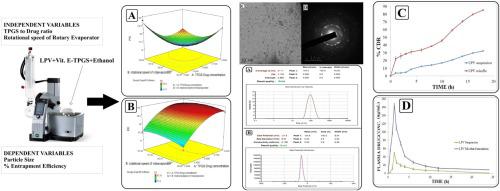Colloids and Surfaces B: Biointerfaces ( IF 5.8 ) Pub Date : 2020-05-26 , DOI: 10.1016/j.colsurfb.2020.111149 Hitendra Shaligram Mahajan 1 , Payal Hasmukhlal Patil 2

|
This study was aimed at formulating Lopinavir loaded Vitamin E-TPGS micelles to enhance its oral bioavailability. Lopinavir is an HIV-1 protease inhibitor with low aqueous solubility leading to poor oral bioavailability and thus frequent dosing. Drug loaded micelles were fabricated using thin film hydration technique and optimized by two-factor five-level central composite design. For this purpose independent variables selected were TPGS to drug ratio and rotational speed of rotary evaporator, whereas dependent variables chosen were particle size and % entrapment efficiency. The effect of an independent variable on the dependent variable was studied by generating a quadratic polynomial model. Results of in vitro characterization showed that prepared lopinavir micelles exhibited particle size 91.71 nm, polydispersity index 0.129, zeta potential −24.8 mV, entrapment efficiency 99.36 ± 1.06% and drug loading 20.83 ± 1.23%. Results of DSC and P-XRD evaluation revealed that drugs were successfully encapsulated inside the Vitamin E-TPGS micelles. In vitro release studies displayed enhancement in drug dissolution as a result of its loading into micelles. TEM images showed that micelles were spherical. On oral administration of lopinavir micelles; the relative bioavailability was boosted by 3.17 folds compared to lopinavir suspensions. Thus, we can conclude that TPGS based micelles possess the prodigious potential to overcome the challenges of current HAART therapy.
中文翻译:

洛匹那韦维生素E-TPGS胶束的基于中央复合设计的优化:体外表征和体内药代动力学研究。
这项研究旨在配制洛潘那韦负载的维生素E-TPGS胶束,以增强其口服生物利用度。Lopinavir是一种HIV-1蛋白酶抑制剂,具有低水溶性,导致不良的口服生物利用度,因此给药频繁。使用薄膜水化技术制备载药胶束,并通过两因素五级中心复合设计进行优化。为此,选择的自变量为TPGS与药物的比例和旋转蒸发仪的转速,而选择的因变量为粒径和包封率%。通过生成二次多项式模型研究了自变量对因变量的影响。体外结果表征表明,制备的洛匹那韦胶束的粒径为91.71 nm,多分散指数为0.129,ζ电势为-24.8 mV,包封率为99.36±1.06%,载药量为20.83±1.23%。DSC和P-XRD评估的结果表明,药物被成功地封装在维生素E-TPGS胶束中。体外释放研究表明,由于将药物加载到胶束中,药物的溶解度有所提高。TEM图像表明,胶束是球形的。口服洛匹那韦胶束;与洛匹那韦混悬液相比,相对生物利用度提高了3.17倍。因此,我们可以得出结论,基于TPGS的胶束具有克服当前HAART治疗挑战的巨大潜力。


























 京公网安备 11010802027423号
京公网安备 11010802027423号